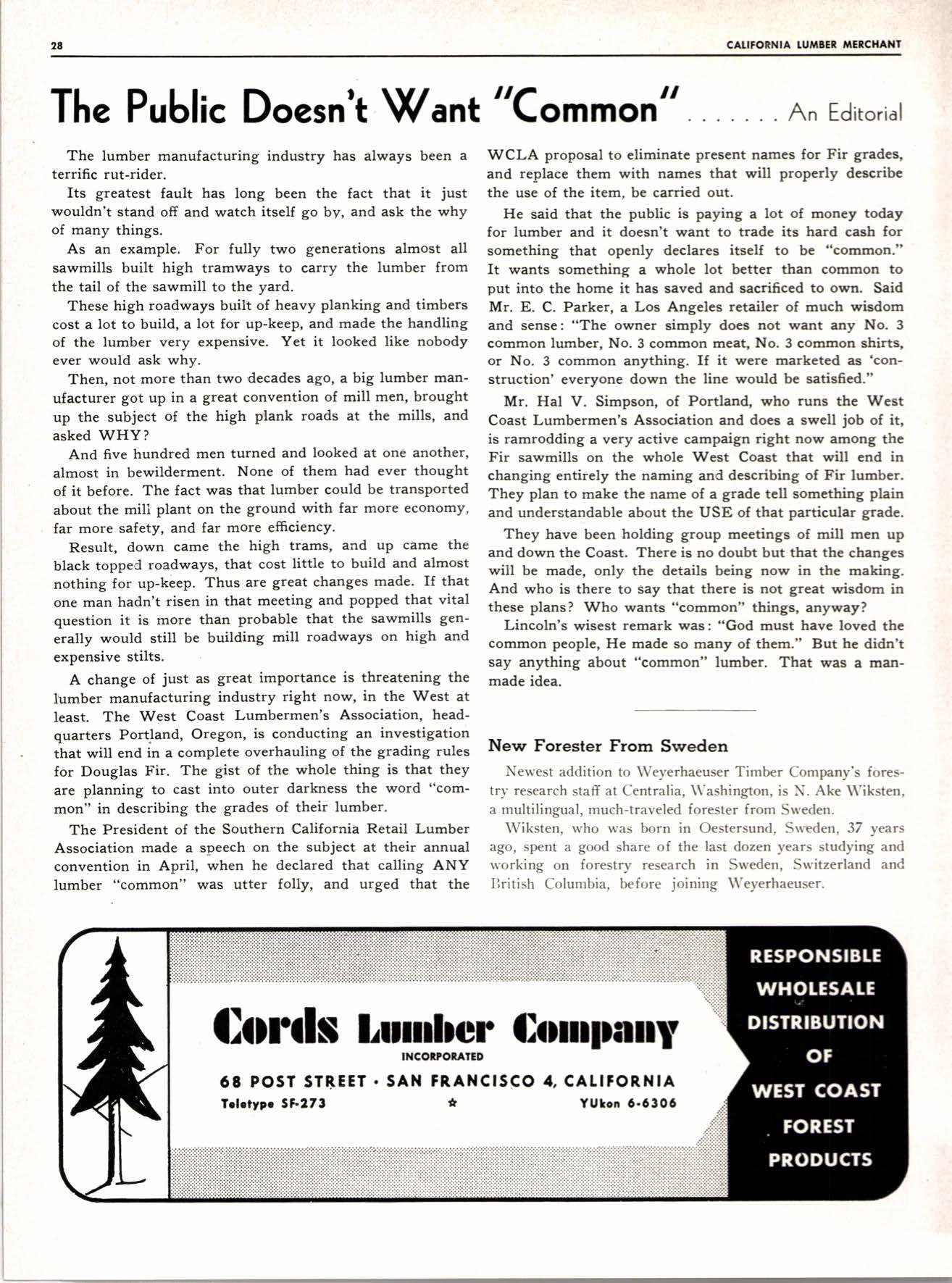
2 minute read
The Public Doesn't Want "Cotmon" ... An Editorial
The lumber manufacturing industry has always been a terrific rut-rider.
fts greatest fault has long been the fact that it just wouldn't stand off and watch itself go by, and ask the why of many things.
As an example. For fully two generations almost all sawmills built high tramways to carry the lumber from the tail of the sawmill to the yard.
These high roadways built of heavy planking and timbers cost a lot to build, a lot for up-keep, and made the handling of the lumber very expensive. Yet it looked like nobody ever would ask why.
Then, not more than two decades ago, a big lumber manufacturer got up in a great convention of mill men, brought up the subject of the high plank roads at the mills, and asked WHY?
And five hundred men turned and looked at one another, almost in bewilderment. None of them had ever thought of it before. The fact was that lumber could be transported about the mili plant on the ground with far more economy, far more safety, and far more efficiency.
Result, down came the high trams, and up came the black topped roadways, that cost little to build and almost nothing for up-keep. Thus are great changes made. If that one man hadn't risen in that meeting and popped that vital question it is more than probable that the sawmills generally would still be building mill roadways on high and expensive stilts.
A change of just as great importance is threatening the lumber manufacturing industry right now, in the West at least. The West Coast Lumbermen's Association, headquarters Portland, Oregon, is conducting an investigation that will end in a complete overhauling of the grading rules for Douglas Fir. The gist of the whole thing is that they are planning to cast into outer darkness the word "common" in describing the grades of their lumber.
The President of the Southern California Retail Lumber Association made a speech on the subject at their annual convention in April, when he declared that calling ANY lumber "common" was utter folly, and urged that the
WCLA proposal to eliminate present names for Fir grades, and replace them with ninres that wiU properly describc the use of the item, be carried out.
He said that the public is paying a lot of money today for lumber and it doesn't want to trade its hard cash for something that openly declares itself to bc "common." It wants something a whole lot better than common to put into the home it has saved and sacrificed to own. Said Mr. E. C. Parker, a Los Angeles retailer of much wisdom and sense: "The owner simply does not want any No. 3 common lumber, No.3 common meat, No. 3 common shirt+ or No. 3 common anything. If it were marketed as 'construction' everyone down the line would be satis6ed."
Mr. Hal V. Simpson, of Portland, who runs the West Coast Lumbermen's Association and does a swell job of it, is ramrodding a very active campaign right now among the Fir sawmills on the whole West Coast that will end in changing entirely the naming and describing of Fir lumber. They plan to make the name of a grade tell sometting plain and understandable about the USE of that particular grade.
They have been holding group meetings of mill men up and down the Coast. There is no doubt but that the cbanges will be made, only the details being now in ttre making. And who is there to say that there is not great wisdom in these plans? Who wants "common" things, anyway?
Lincoln's wisest remark was: "God must have loved the common people, He made so man5r of them." But he didn't say anything about "common" lumber. That was a manmade idea.
New Forester From Sweden
Newest addition to Weyerhaeuser Timber Company's forestrv research staff at Centralia, \\'ashington, is N. Ake \\'iksten, a multilingual, much-traveled forester from Sweden.
Wiksten, lvho u'as born in Oestersund, Ss-eden, 37 years ago, spent a good share of the last dozen vears studying and rvorking on forestry research in Sweden, Su'itzerland and Iiritish Columbia, before joining \\'eyerhaeuser.










